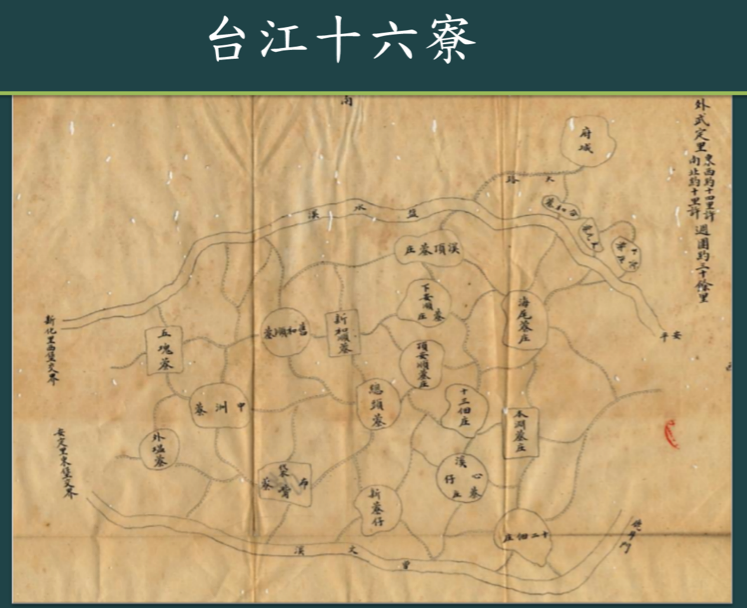

-
- 111th Academic Year
- The Avenue of NCKU Heritage – Area of Cultural Assets
- The Avenue of NCKU Heritage – Area of Environment and Ecology
- From country to city: Taveron and Han integration
- Kyrie: Pestilence and faith in the salty area
- Highlighting Western Chu-Wei
- Ginza: Commercial tracks from harbors to modern streets
- Tavocan and the Town of Hills
- The Museum: Ecological village and eco-museum
- The Stories about Major South Gate of Fu-Chen (Tainan)
- Modern new generation
- 110th Academic Year
- The Route of NCKU Students - The Cultural Assets Area
- NCKU Students' Route – Area of Cultural Assets
- Migration and Settlement of the Siraya Tribe
- Zengwen Creek’s nine bends and 18 turns, with astronomy, hydrology and humanities
- Exploring the Old Industries of Tainan City
- Journey of Beauty
- The Narrations of Water Resources, Agriculture and Livestock Industries
- Exploring Old Yuejin Harbor Area
- Lâu-Nuā Sió Sai Kha
- Highlighting Western Chu-Wei Area, Yu-Ler Street & Eastern Gate
- 109th Academic Year
- NCKU Students' Route – Area of Cultural Assets
- NCKU Students' Route – Area of Environment and Ecology
- Migration and Settlement of the Siraya Tribe
- Old Taijiang Inner Sea: Its Previous and Current Existence
- Lâu-noā Sió-sai-kha
- Exploring the Old Industries of Tainan City
- The Exploitation of the Works of Nature-Journey about The Frost and The Flower of Salt
- Badlands and the Mountain City
- Age-old Stories from the South of the City
- The Magnificent of Zheng-Xing Street
- 108th Academic Year
- The Route of NCKU Students─The Cultural Assets Area
- NCKU Students' Route – Area of Environment and Ecology
- Ecology of Fishery and Sea Salt Harvesting─ The Nature and Culture of Tai-Jiang Lagoon
- Migration and Settlement of the Siraya Tribe
- Age-old Stories from the South of the City
- Exploring the Old Industries of Tainan City
- The Narrations of Water Resources, Agriculture and Livestock Industries
- Technology and Humanities Science Park and Cultural Archeology
- From Kū-Lâu to Sin-Lâu Hospital
- Folk Delicacy around Minor West Gate Area
- 107th Academic Year
- The Avenue for NCKU Students
- Exploring Old Occupations in Tainan
- Secret Literary Path of Tainan
- Migration and Settlement of the Siraya Tribe
- Old Tai Jang Inner Sea: Its Previous and Current Existence
- Five-Canal Harbor Area: The Water Gods and Import-Export Tradesmen
- Tradition and Innovation: Zhengxing Street and the Grand Market(Da Caishi)
- The Water Resource of Tainan Area
- The Grace of Yanshui Harbor: Rejuvenation of Yanshui and Hopi Settlements
- 106th Academic Year
- The Avenue of NCKU Students
- Gate of Urn-Shaped Castle and the Stony Plates
- Siraya People’s Migration and Their Journey to Settlement
- Zeelandia and the Retrospective Anping
- Old Taijang Inner Sea (Taijang Nei Hai ) : Its Previous and Current Existence
- Tradition and Innovation- Zhengxing Street and the Grand Market (Da Caishi )
- Qing Dynasty Government Official’s Trail-Chunan Old Street and Zhenbei Fang
- Five-Canal Harbor Area, the Water Gods and Import-Export Tradesmen
- Fantastic Trips to Know Sugar and Salt production
- Chikan Park Area and Historical Traces
- Secret Garden of Literature- From Taiwan Administration (Taiwan Fu) to Tainan Prefecture Hall (Tainan Zhou Ting)
- The Water World of Tainan Area
- 111th Academic Year
-
-
-
Old Tai Jang Inner Sea: Its Previous and Current Existence
Route Introduction

16 Villages of Taijiang
Fostering education in the big temples
The Annan District of Tainan City was called Taijiang in ancient times. In 1823, Zengwun Creek rerouted, and the inner sea became arable land. People from the north bank of the river, such as Jiangjun, Beimen and Xuejia, gradually moved to this area. They built their villages and set up schools.
This was how the area received the name: 16 villages of Taijiang. Among them, twelve were built in Tongzhi Era of Qing Dynasty; the 16 villages were formed in the late 19th century. Haiwei, Sicao and Anping were located in the three corners of a triangle area, which was the Taijiang Port in the Dutch colonial era, also known as the Inner Harbor of Luermen.
This inland sea lagoon, along with the alluvium of Zengwun Creek, Luermen Creek and Yanshuei River, had gradually deposited into today's Sicao wetlands. This area was also the important naval battle fields in Taiwan history between General Zheng Cheng- Gong and the Dutch, Lan Ting-Zhen and Zhu Yi-Gui, Wang De-Lu and Cai Qien.
"Haiwei Dadaogong Temple", today's Chao-Huang Temple, worshipping Baosheng Emperor, was used as the local school. It was a center of faith and culture, carried with it three communal functions - "social participation", "community learning" and “cultural beliefs".
The early immigrants to Taijiang built the settlements with coral stones, and formed "gongzi" (public school) and "private study" together with the religious center. They hired scholars to teach children and marked the first page of the history of education in Haiwei two hundred years ago.
-